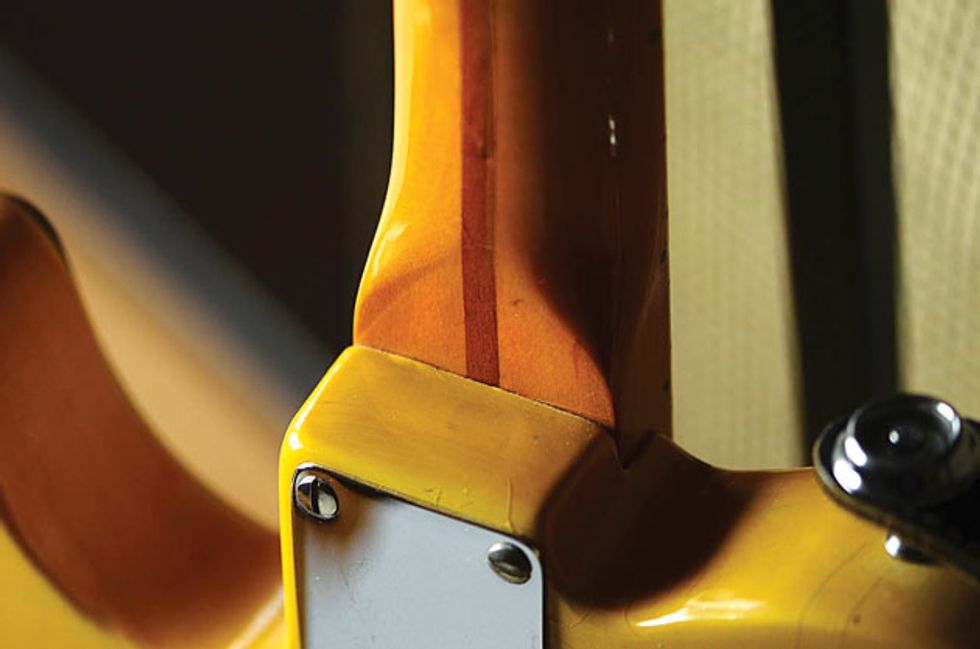Have you ever wondered why guitars are designed the way they are? I’m not talking about their general shape or basic layout, but, instead, the little details that make each instrument unique. Many of these elements have passed into the realm of fashion, but actually began with a structural purpose—like copper rivets on blue jeans. I recently wrote about the arched top—which is an obvious example—but if you look a little more closely at instruments, a pattern emerges.
As much as any appeal to the eyes, manufacturing efficiencies run high on the list of motivations for much of what we accept as normal today. The bolt-on neck is an object lesson on how to simplify building and streamline production. Although it was a bit of a stretch in the beginning to get musicians to accept the idea, it is generally regarded as just another feature today. Saving money, maximizing profit, reducing waste, and even lowering prices are some of the driving forces in the details we encounter on our guitars. Here are a few of my favorites—dubious and otherwise.
The dimple face. A designer attempting to integrate electronic controls into an instrument with a curved top used to have only a few options. Today, a designer using CNC can route angled and stepped control cavities that allow switches and pots to follow the shape of an instrument’s carved top. Multi-axis machines can create concave shapes and angled surfaces with comparative ease. But not too long ago, when time consuming and less flexible manual routing was the norm, the only way to get controls to conform to an arched shape was through multiple, stepped interior routs. Enter the dimple face. By drilling away a contoured divot around a switch or volume knob on the outside, a builder is able to simplify the production process using a single-depth control rout inside. The smoothly sanded craters in a guitar’s face were unusual at first, but now they are just considered a style choice.
The pancake body. Materials can be expensive—especially when it’s Honduran mahogany or other choice woods. It’s also harder to find wide, thick slabs that are big enough to make a single-piece body or neck. Because thinner boards are cheaper and more plentiful, it stands to reason that laminated guitar parts save money. In the case of a guitar neck, it’s a tradeoff between structural stability and beauty, but in the body of a guitar, cost is truly the issue.
As the guitar craze of the ’60s continued into the ’70s, big companies churned out thousands of guitars each day and it became routine for builders to laminate bodies and necks to maximize output and profits. Fender had already used multi-piece bodies for decades, but it was in the ’70s that Gibson really upped the ante with the famous pancake body. The process of sandwiching two pieces of wood together with a thin sheet of contrasting-colored wood in between became a short-lived experiment on their newly reissued Les Paul. I’m not sure what killed off the idea, but it certainly wasn’t popular with musicians and actually helped launch the vintage market.
All-in-one pickguards. The 1954 Stratocaster was a tour de force of manufacturing strategy, and one of its most overlooked contributions was the use of a pickguard as an electronics subassembly. The white-plastic pickguard had a slick, mid-century modern appearance to it, but its futuristic facade concealed a greater purpose. There had been jazz guitars with integrated pickguard/pickups before, such as the 1949 Gibson Super 400, but the idea of mounting all of the electronics on a separate plate was groundbreaking. Now the entire wiring process could be done separately from the guitar, and then simply installed at the proper point in the assembly line.
Skunk stripe. Another Fender characteristic is the dark-wood strip down the center of the back of the neck. I’d been playing a Telecaster for a while before it dawned on me that this distinctive feature was not decorative, but actually where the truss rod had been inserted. What to do when your neck has no fretboard to cover the rod? Cut a groove in the back and then hide it in plain sight with a contrasting ribbon of wood!
German carve. The resurgence of bargain-basement instruments of the ’60s has brought with it a new appreciation of what is referred to the as the German carve. European luthiers favored this step-like, sculpted technique, which is reminiscent of something associated more with tables or desks. Rickenbacker designer Roger Rossmeisl made furniture-based faux carving famous in the late ’50s, and the technique was again seen on the Mosrite Ventures models in the ’60s (purportedly because Mosrite founder Semie Moseley had worked for Rossmeisl at Rickenbacker). Although it stands on its own as a design esthetic, it is far easier to learn and accomplish than a violin-style top carve, explaining why many cheap instruments of the ’60s guitar boom rocked the German carve. Shabby chic, indeed.
These are just a few of the little mysteries and stories that surround the details of the guitar. I’m sure you have your own favorites, be it upside-down headstocks, zebra paint jobs, or humbuckers screwed straight into the body wood. There’s no end to it, nor would we wish it so. Variety, no matter the motivation, is the hot sauce of life.















![Rig Rundown: Russian Circles’ Mike Sullivan [2025]](https://www.premierguitar.com/media-library/youtube.jpg?id=62303631&width=1245&height=700&quality=70&coordinates=0%2C0%2C0%2C0)









